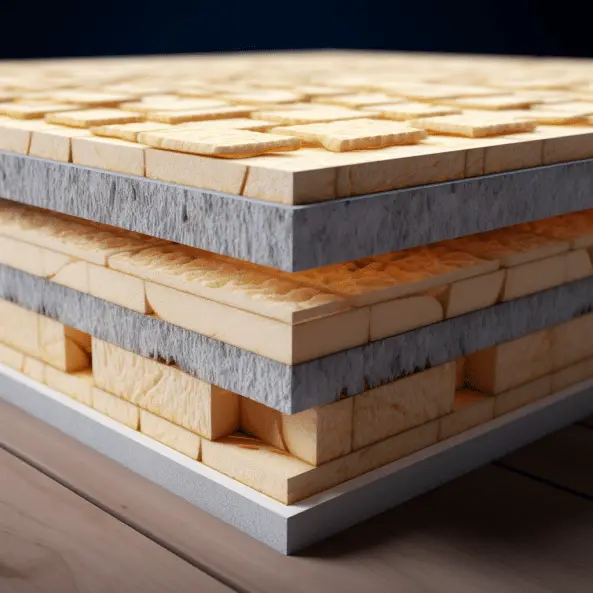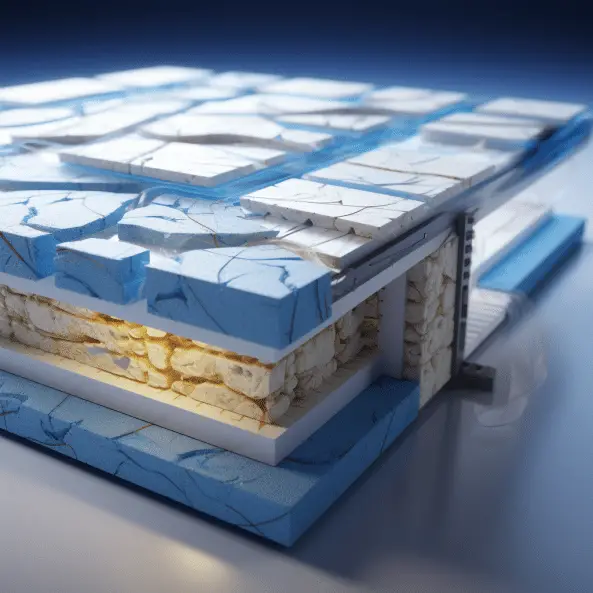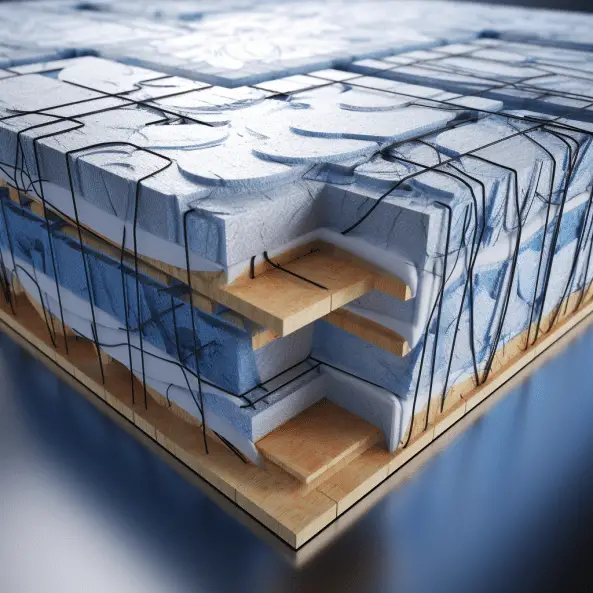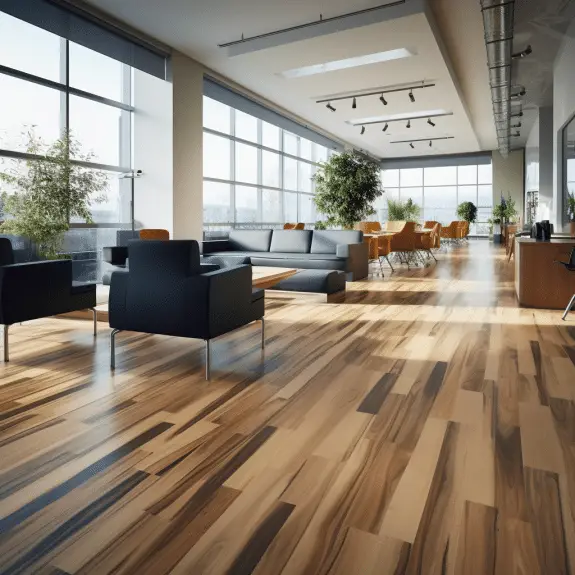Innovative PU Insulation: A Blueprint for Energy Efficiency
Energy-efficient construction is crucial for climate protection, and innovative insulation materials play a significant role in achieving this. The Baugenossenschaft Überlingen neighborhood housing project in Germany is a prime example of how innovative polyurethane (PU) insulation from puren can combine energy efficiency, affordability, and social balance. PU insulation materials offer exceptional thermal insulation values and enable the reduction of energy consumption and CO2 emissions in buildings. They allow for high energy efficiency while taking up less space, preserving valuable living space and reducing costs. PU insulation panels were used in various parts of the project, including the ceiling of the underground parking garage and the facades, contributing to the overall energy efficiency and affordability of the development. PU insulation materials are also recyclable, making them a sustainable choice for building projects.
Key Takeaways:
- Energy-efficient construction is essential for climate protection.
- Innovative insulation materials, like PU, contribute to energy efficiency and affordability.
- PU insulation enables the reduction of energy consumption and CO2 emissions.
- PU insulation materials preserve living space and reduce costs.
- PU insulation is recyclable, adding to its sustainability.
Energy-Efficient Construction: A Case Study of Baugenossenschaft Überlingen
The Baugenossenschaft Überlingen neighborhood housing project in Germany is an example of energy-efficient, climate-neutral, and affordable building. This project shows how novel insulation materials like polyurethane (PU) insulation may fulfill high energy standards and social harmony with 180 residential units in 14 buildings.
The Baugenossenschaft Überlingen project achieved the KfW Efficiency House 40 Plus standard, which combines top energy standards with social balance. PU insulation materials were selected to meet these requirements, enabling the project to achieve climate neutrality and reduced energy consumption. The use of PU insulation panels, including in the ceilings of the underground parking garage and the facades, contributed to the overall energy efficiency and affordability of the development.
This case study emphasizes that energy-efficient construction and affordable housing can coexist through the utilization of innovative insulation materials like PU. By embracing energy-efficient practices and materials, developers can create sustainable living environments that benefit both residents and the environment.
The Key Features of Baugenossenschaft Überlingen’s Energy-Efficient Construction:
- Combination of high energy standards and social balance
- Achievement of the KfW Efficiency House 40 Plus standard
- Utilization of polyurethane (PU) insulation materials
- Contribution to climate neutrality and reduced energy consumption
- Integration of PU insulation panels in various parts of the project
- Focus on energy efficiency, affordability, and sustainability
Table: Energy-Efficient Features of Baugenossenschaft Überlingen
| Energy-Efficient Features | Benefits |
|---|---|
| KfW Efficiency House 40 Plus standard | High energy performance and reduced environmental impact |
| Polyurethane (PU) insulation materials | Exceptional thermal insulation and energy efficiency |
| Climate-neutral construction | Reduced carbon emissions and sustainable living |
| Integration of PU insulation panels | Enhanced energy efficiency and affordability |
By showcasing the success of Baugenossenschaft Überlingen, this case study highlights the possibilities and benefits of energy-efficient construction. It serves as an inspiration for future projects to prioritize energy efficiency, climate neutrality, and affordable living.

Benefits of PU Insulation Materials
PU insulating materials reduce energy consumption and CO2 emissions in energy-efficient construction. Even at minimal thickness, PU insulation materials provide excellent thermal insulation, resulting in good energy efficiency. This allows structures to maximize insulation without losing living space. PU insulation materials are space-saving, making them appropriate for home developments that prioritize cost and affordability.
PU insulation products are recyclable and energy-efficient, making them a sustainable construction resource. Developers may promote a circular economy and reduce environmental impact by employing recyclable materials. PU insulation can be recycled, saving resources for future construction projects and promoting sustainability.
PU insulation materials offer a complete energy-efficient construction solution. Their thermal insulation, space-saving, and recyclability make them ideal for structures that want to save energy, CO2, and promote sustainability. With its ability to produce comfortable and eco-friendly living spaces, PU insulation materials are greening the construction industry.
| Benefits of PU Insulation Materials |
|---|
| Exceptional thermal insulation values |
| Space-saving, allowing for optimal energy efficiency without sacrificing living space |
| Recyclable, contributing to a sustainable construction industry |
Innovative Insulation: The Future of Thermal Efficiency
Innovative insulation materials with a low lambda value are revolutionizing thermal efficiency in buildings. These materials offer exceptionally high insulation performance at minimal thickness, leading to significant energy savings and space optimization. One such material is Aerogel Insulation Technology, which provides 39 times more insulation than traditional fiberglass insulation. Its lightweight and dense structure allow for improved energy efficiency and increased usable space within rooms.
“Aerogel insulation is a game changer in the world of thermal insulation. With its remarkable insulation performance, it offers a solution to the perennial challenge of limited space in buildings. It allows us to achieve higher levels of energy efficiency without compromising on design or comfort.” – Peter Johnson, Architect
Another innovative option is spray foam technology, which provides seamless insulation coverage and eliminates thermal bridging and draft issues. Its ability to fill hard-to-reach areas enhances both energy efficiency and comfort. Additionally, insulated concrete forms technology, utilizing styrofoam-filled concrete blocks, offers simultaneous insulation from both the exterior and interior, resulting in exceptionally low thermal transmittance.
Advantages of Innovative Insulation Materials:
- High insulation performance at minimal thickness
- Significant energy savings and reduced heating costs
- Increased usable space within rooms
- Elimination of thermal bridging and draft issues
- Enhanced comfort and indoor air quality
With these innovative insulation materials, the future of thermal efficiency in buildings is bright. They provide sustainable solutions for reducing energy consumption, enhancing comfort, and optimizing space utilization. As the demand for energy-efficient construction continues to grow, these materials will play a crucial role in creating a greener and more sustainable future.
| Insulation Material | Insulation Performance | Thickness | Space Saving |
|---|---|---|---|
| Aerogel Insulation Technology | 39 times more insulation than fiberglass | Minimal thickness | Increased usable space within rooms |
| Spray Foam Technology | Seamless insulation coverage | Varies | Elimination of thermal bridging and draft issues |
| Insulated Concrete Forms | Exceptionally low thermal transmittance | Varies | Suitable for simultaneous exterior and interior insulation |
Advanced Insulation Technologies: What’s New in the Industry
The insulation industry is constantly evolving, introducing advanced technologies that push the boundaries of energy efficiency and space optimization. These innovations offer exciting prospects for the future of construction and sustainability. Two notable advancements in insulation technologies are aerogel insulation and spray foam technology, both of which offer significant benefits in terms of thermal performance and insulation effectiveness.
Aerogel Insulation
Aerogel insulation technology is a game-changer in the industry. This innovative material, derived from a unique jelly-like substance with interconnected nanometer-sized particles, provides exceptional thermal insulation performance. With its low thermal conductivity, aerogel insulation offers superior insulation properties at a minimal thickness. It effectively reduces heat transfer, ensuring energy efficiency and maximizing usable space within buildings.
Spray Foam Technology
Spray foam technology is another groundbreaking development in insulation. It offers seamless and airtight insulation coverage, eliminating thermal bridging and preventing drafts. Compared to traditional insulation methods, spray foam provides superior energy-saving benefits and soundproofing capabilities. It is also environmentally friendly, resistant to mold and fungi, and can be applied to reach even the most challenging areas of a building.
“Aerogel insulation and spray foam technology are revolutionizing the industry by offering enhanced thermal performance and energy efficiency. These advanced insulation technologies have the potential to transform the way we design and construct buildings, leading to more sustainable and comfortable living spaces.”
– Industry Expert
The application of advanced insulation technologies like aerogel insulation and spray foam technology represents a significant step forward in achieving energy-efficient and environmentally friendly buildings. These innovations provide excellent insulation properties, reduce energy consumption, and contribute to the overall sustainability of constructions. As the industry continues to advance, we can expect further exciting developments in insulation materials and technologies that will shape the future of sustainable construction.
| Advancement | Benefits |
|---|---|
| Aerogel Insulation | Exceptional thermal insulation performance at minimal thickness; Maximizes usable space within buildings |
| Spray Foam Technology | Seamless and airtight insulation coverage; Superior energy-saving benefits and soundproofing capabilities |
Exciting Developments in Insulation Materials: Case Study of BTO’s R&D Program
Innovative insulation material R&D programs are led by the Building Technologies Office (BTO). A BTO R&D project to develop an insulation material with high energy efficiency, heat retention, and cost reductions is intriguing. This effort with Oak Ridge National Laboratory (ORNL) created modified atmosphere insulation (MAI) panels with twice the energy efficiency of normal insulation materials.
A BTO R&D project produced MAI panels to revolutionize building insulation. These panels generate an effective heat barrier using innovative technologies and materials. MAI panels reduce heat transfer and air infiltration, saving energy and improving building comfort. Their excellent heat retention capabilities assist maintain consistent indoor temperatures, decreasing the need for excessive heating or cooling and saving homeowners and building owners money.
The BTO’s R&D program
Besides MAI panels, the BTO’s R&D program is investigating new insulating materials and technologies. R10 insulated vinyl siding combines vinyl siding’s aesthetics with energy efficiency. This improvement gives households better insulation and a nicer outside. The BTO’s R&D program is also studying polymeric vacuum insulation spheres (PVIS) and vacuum glass technology to improve window thermal performance and heat loss.
| Insulation Material | Key Advantages |
|---|---|
| Modified Atmosphere Insulation (MAI) Panels |
|
| R10 Insulated Vinyl Siding |
|
| Polymeric Vacuum Insulation Spheres (PVIS) |
|
The BTO’s R&D program is creating breakthrough insulating materials for more energy-efficient and cost-effective buildings. MAI panels, R10 insulated vinyl siding, and other revolutionary insulation technologies will save homeowners and building owners energy and increase comfort while helping the environment. These innovative insulating materials are changing the construction industry and creating a more energy-efficient and sustainable built environment.
The Potential Impact of Innovative Insulation on Energy Savings
When it comes to energy consumption in buildings, innovative insulation materials have the potential to make a significant impact. By incorporating high-performance insulation technologies like PU, aerogel, and spray foam, developers and homeowners can achieve substantial energy savings and reduce their carbon footprint. These materials offer superior thermal insulation properties, allowing for better heat retention and a more efficient use of energy.
One of the key benefits of innovative insulation materials is their ability to minimize heat loss, resulting in lower energy bills. By reducing thermal bridging and creating a more airtight building envelope, these materials help to maintain a consistent indoor temperature, reducing the need for heating and cooling systems. This not only saves energy but also enhances the comfort and livability of the space.
Insulation technologies like PU, aerogel, and spray foam also contribute to the sustainability of buildings. With their improved thermal performance, these materials help to reduce the overall energy consumption, leading to a decrease in greenhouse gas emissions. Additionally, many of these innovative materials are recyclable, further promoting a circular economy and minimizing waste.
The Potential Impact of Innovative Insulation on Energy Savings
Table: Comparison of Energy Savings with Different Insulation Technologies
| Insulation Technology | Energy Savings |
|---|---|
| PU Insulation | Up to 50% reduction in energy consumption |
| Aerogel Insulation | Up to 60% reduction in energy consumption |
| Spray Foam Insulation | Up to 40% reduction in energy consumption |
As the demand for energy-efficient buildings continues to grow, the use of innovative insulation materials will play a crucial role in meeting sustainability goals. By adopting these technologies, we can significantly reduce energy consumption, lower our carbon footprint, and create more comfortable and environmentally-friendly spaces.
The Future of Insulation and Sustainable Construction
Innovative circular economy materials will shape insulation’s future as the construction sector prioritises sustainability and energy efficiency. These materials function well and aid building sustainability through recycling and reduced environmental effect.
PU insulation is a popular new material for its thermal insulation and energy savings. By saving space and reducing energy and CO2 emissions, PU insulation improves living space efficiency. Recyclable PU insulation reduces waste and encourages material reuse in future construction projects, contributing to the circular economy.
Besides PU insulation, aerogel and spray foam insulation are transforming the market. Aerogel insulation improves thermal insulation and reduces heat loss while reducing insulation layer thickness. Spray foam eliminates thermal bridging and boosts energy efficiency with seamless insulation.
The Benefits of Innovative Insulation Materials:
- Enhanced energy efficiency
- Reduced energy consumption and CO2 emissions
- Space-saving designs
- Recyclability and contribution to the circular economy
By embracing these innovative insulation materials, the construction industry can create energy-efficient buildings that not only meet the demands of sustainable construction but also contribute to a greener future. As research and development continue to drive advancements in insulation technologies, we can expect further improvements in thermal performance, reduced environmental impact, and increased recyclability, leading to a more sustainable and energy-efficient built environment.
| Innovative Insulation Materials | Benefits |
|---|---|
| PU insulation | Exceptional thermal insulation values, reduced energy consumption, recyclability |
| Aerogel insulation | Highly efficient thermal performance, reduction in heat loss, minimal thickness |
| Spray foam | Seamless insulation coverage, elimination of thermal bridging, improved energy efficiency |
Advancements in Insulation: A Positive Outlook for the Environment
As we strive for greater energy efficiency and climate protection, the advancements in insulation technologies offer a promising outlook for the environment. These innovative insulation materials are playing a crucial role in reducing energy consumption and minimizing CO2 emissions in buildings. By improving thermal performance and creating more sustainable living spaces, they contribute to a greener future.
Insulation innovations such as polyurethane (PU), aerogel, spray foam, and vacuum glass are revolutionizing the construction industry. These materials provide exceptional thermal insulation, reducing heat loss and increasing energy efficiency. They not only help lower energy bills but also create more comfortable and cost-effective living environments.
By embracing these insulation technologies, we can make significant strides towards sustainability. Not only do they contribute to energy-efficient buildings, but they also support the circular economy by being recyclable and environmentally friendly. As the demand for energy-efficient structures continues to grow, these advancements will play a vital role in meeting this demand and ensuring a brighter future for our planet.
Advantages of Innovative Insulation Technologies:
- Significantly reduce energy consumption and CO2 emissions
- Improve thermal performance and energy efficiency
- Create more comfortable and sustainable living spaces
- Lower energy bills and increase cost-effectiveness
- Promote the circular economy through recyclability
“Innovative insulation materials are paving the way for a greener and more sustainable construction industry, where energy efficiency and climate protection are at the forefront of design and development.” – Industry Expert
With continuous advancements in insulation technologies, we can look forward to a future where energy efficiency and climate protection become the standard in the construction industry. By incorporating these innovative materials into our projects, we contribute to a more sustainable and environmentally conscious society.

Conclusion
Innovative insulation materials are transforming the construction industry, offering a pathway to energy-efficient and sustainable buildings. With materials like PU insulation, aerogel, spray foam, and vacuum glass, we can achieve not only significant energy savings but also lower carbon footprints.
By integrating these advanced insulation solutions into construction projects, we can enhance thermal performance while promoting affordability and sustainability. These materials provide exceptional energy efficiency, reducing energy consumption and CO2 emissions. They also contribute to the creation of more comfortable and environmentally conscious living spaces.
Embracing innovative insulation materials is a crucial step towards building a greener future. As the demand for energy-efficient buildings continues to grow, advancements in insulation technologies will play a vital role in meeting sustainability goals. By harnessing the power of these materials, we can pave the way for a construction industry that aligns with the principles of the circular economy.
With a focus on innovative insulation materials, we can achieve not only energy efficiency but also sustainability in our buildings. By continuously pushing the boundaries of insulation technology, we can create a positive impact on the environment and work towards a more sustainable future.
FAQ
Why are energy-efficient construction and thermal insulation important?
Energy-efficient construction and thermal insulation are crucial for reducing energy consumption and CO2 emissions in buildings, leading to climate protection and sustainability.
What is the Baugenossenschaft Überlingen neighborhood housing project?
The Baugenossenschaft Überlingen neighborhood housing project is a renowned development in Germany that combines energy efficiency, affordability, and social balance in its construction and renovation of residential units.
How do PU insulation materials contribute to energy efficiency?
PU insulation materials have exceptional thermal insulation values, allowing for reduced energy consumption in buildings. They also save space, preserve valuable living space, and reduce costs.
What are some innovative insulation materials with low lambda values?
Aerogel insulation technology, spray foam technology, and insulated concrete forms technology are examples of innovative insulation materials that offer high thermal performance and space optimization.
What are the benefits of advanced insulation technologies?
Advanced insulation technologies, such as aerogel insulation and spray foam technology, provide enhanced thermal performance, airtightness, soundproofing capabilities, and precise filling of hard-to-reach areas.
What is the Building Technologies Office (BTO) and its R&D program?
The Building Technologies Office (BTO) invests in research and development programs to advance insulation materials. Their projects include the development of high-efficiency insulation materials and technologies like modified atmosphere insulation panels and R10 insulated vinyl siding.
How can innovative insulation materials contribute to energy savings?
By reducing heat loss and improving thermal performance, innovative insulation materials can lead to lower energy bills, increased comfort, and overall energy savings in residential and commercial buildings.
What is the future of insulation and sustainable construction?
The future lies in the adoption of innovative materials that align with the principles of the circular economy, offering recyclability, improved thermal performance, reduced environmental impact, and increased material recyclability.
What is the potential impact of innovative insulation on the environment?
Innovative insulation materials promote energy efficiency, climate protection, and the creation of more comfortable and sustainable living spaces, leading to a greener future.
What are the main takeaways from the use of innovative insulation materials?
The use of innovative insulation materials enables energy-efficient and sustainable buildings, reducing energy consumption, lowering carbon footprints, and contributing to affordability and overall sustainability in construction.








